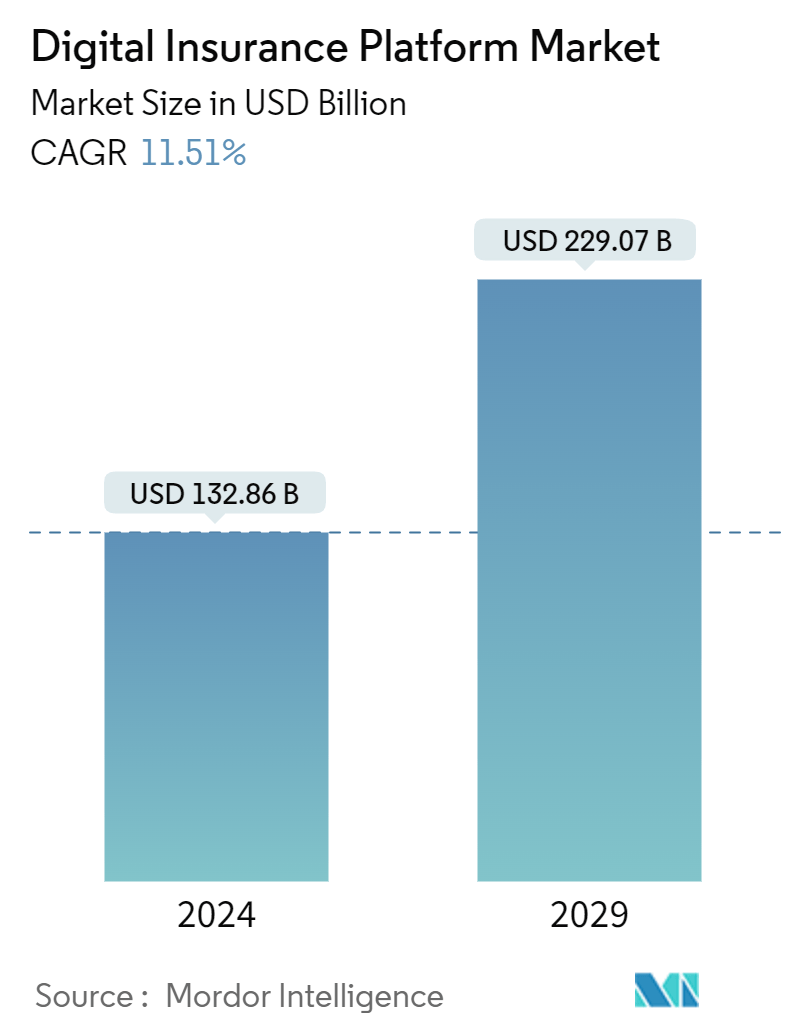Market Size of Digital Insurance Platform Industry

| Study Period | 2019 - 2029 |
| Market Size (2024) | USD 132.86 Billion |
| Market Size (2029) | USD 229.07 Billion |
| CAGR (2024 - 2029) | 11.51 % |
| Fastest Growing Market | North America |
| Largest Market | Asia Pacific |
| Market Concentration | Low |
Major Players
*Disclaimer: Major Players sorted in no particular order |
Digital Insurance Platform Market Analysis
The Digital Insurance Platform Market size is estimated at USD 132.86 billion in 2024, and is expected to reach USD 229.07 billion by 2029, growing at a CAGR of 11.51% during the forecast period (2024-2029).
Insurtech companies are disrupting the insurance industry by building digital platforms and collaborating with insurance companies and suppliers. The paradigm shift from a product-centric model in traditional insurance companies to a primarily client-centric model has been enabled by the digital insurance platforms enabled by technologies like IoT, Big data analytics, blockchain, artificial intelligence, and cloud computing.
- Customer loyalty and satisfaction have become primary concerns for insurance companies. Artificial intelligence (AI) and related technologies are expected to significantly impact all aspects of the insurance value chain, from distribution to underwriting and pricing to claims management. This may result in policies being priced, purchased, and bound in near real-time. Through these, insurers have been able to smartly connect information and quickly deliver innovative products and services, which, in the end, will significantly improve customer loyalty and satisfaction.
- Signs of massive and unprecedented progress are observed across the insurance industry. Explore new technologies and partner with insurance companies and their existing technology partners to develop new models and tools. Others stimulate their business results by executing quick minimum viable products (MVPs), proof of concepts (POCs), and straight into production.
- Many seek ways to speed up their existing digital roadmaps during and post-pandemics. And some are exploring new outsourcing solutions to drive agility. Over the past few months, the market has focused on digitizing the contact centers and the claims functions. Notably, significant progress was made in adopting automation and process streamlining, improving the use of structured and unstructured data, external data, and the exploratory use of knowledge.
- On the flip side, the shift to digital insurance has increased the volume of data required and the variety of methods for processing it. When updating its catastrophe models, an insurance company, for instance, needs to know how many houses and businesses are vulnerable to manage risk and adjust its writings accordingly. In the future, a more comprehensive range of threats will need to be covered by catastrophe modeling. Further, insurance firms, particularly those who sell cyber insurance, have a specific obligation to protect their systems and data against hacking to manage risk and maintain the trust of their insured. Insurance providers require the appropriate procedures to manage their insured's information securely.
- Cloud computing allows insurance companies to scale their operations up or down quickly in response to changing business needs. This scalability and flexibility are crucial in handling fluctuations in customer demand and adapting to market changes.
- Integrating digital insurance platforms with the lagacy system is a common challange in the insurance industry and can restrain the growth of the digital insurance platform market. Several difficulties and complexities associated with this integration can hinder the adoption and implementation of modern digital solutions.
Digital Insurance Platform Industry Segmentation
Digital insurance platforms support insurers by enhancing the efficiency of central-core systems and the differentiation of easy-to-compose customer experience. The digital insurance platform providers' prime responsibility is to ensure the proper deployment and integration of digital insurance solutions as per the specific requirements of clients. By type of deployment, the market is divided into on-premise and cloud. The organization size segments include large enterprise and small and medium enterprises.
The digital insurance platform market is segmented by deployment (on-premise, cloud), by organization size (large enterprise, small & medium enterprise), by application (automotive and transportation, home & commercial buildings, life & health, business & enterprise, consumer electronics & industrial machines, travel), by geography (North America, Europe, Asia Pacific, Latin America, and Middle East and Africa). The market sizes and forecasts are provided in terms of value in USD for all the above segments.
| By Deployment | |
| Cloud | |
| On-premise |
| By Organization Size | |
| Large Enterprises | |
| Small and Medium Enterprises |
| By Application | |
| Automotive and Transportation | |
| Home and Commercial Buildings | |
| Life and Health | |
| Business and Enterprise | |
| Consumer Electronics and Industrial Machines | |
| Travel |
| By Geography*** | ||||||
| ||||||
| ||||||
| ||||||
| Latin America | ||||||
| Middle East and Africa |
Digital Insurance Platform Market Size Summary
The Digital Insurance Platform Market is experiencing a transformative phase, driven by the integration of advanced technologies such as IoT, Big Data analytics, blockchain, artificial intelligence, and cloud computing. This shift from a product-centric to a client-centric model is reshaping the insurance landscape, with insurtech companies playing a pivotal role in disrupting traditional practices. The focus on enhancing customer loyalty and satisfaction is paramount, as these platforms enable insurers to offer innovative products and services swiftly. The adoption of digital solutions is also facilitating the digitization of contact centers and claims functions, improving data utilization, and streamlining processes. However, challenges such as the integration of digital platforms with legacy systems and the management of increased data volumes and security concerns remain significant hurdles.
The market is witnessing a surge in demand for cloud-based solutions, which offer scalability, flexibility, and cost-efficiency, crucial for adapting to fluctuating customer demands and market changes. Cloud technology is enhancing the claims experience and improving customer engagement through better communication and targeted campaign management. The emergence of insurance ecosystems, particularly in the Asia-Pacific region, is further driving the adoption of digital insurance platforms. This region is poised for substantial growth, with significant investments in digitalization and the development of integrated platforms that offer a range of services. Major players in the market, including IBM, Microsoft, and Oracle, are leveraging strategic partnerships and acquisitions to enhance their offerings and maintain a competitive edge.
Digital Insurance Platform Market Size - Table of Contents
-
1. MARKET INSIGHTS
-
1.1 Market Overview
-
1.2 Industry Attractiveness - Porter's Five Forces Analysis
-
1.2.1 Threat of New Entrants
-
1.2.2 Bargaining Power of Buyers/Consumers
-
1.2.3 Bargaining Power of Suppliers
-
1.2.4 Threat of Substitute Products
-
1.2.5 Intensity of Competitive Rivalry
-
-
1.3 Assessment of COVID-19 impact on the industry
-
-
2. MARKET SEGMENTATION
-
2.1 By Deployment
-
2.1.1 Cloud
-
2.1.2 On-premise
-
-
2.2 By Organization Size
-
2.2.1 Large Enterprises
-
2.2.2 Small and Medium Enterprises
-
-
2.3 By Application
-
2.3.1 Automotive and Transportation
-
2.3.2 Home and Commercial Buildings
-
2.3.3 Life and Health
-
2.3.4 Business and Enterprise
-
2.3.5 Consumer Electronics and Industrial Machines
-
2.3.6 Travel
-
-
2.4 By Geography***
-
2.4.1 North America
-
2.4.1.1 United States
-
2.4.1.2 Canada
-
-
2.4.2 Europe
-
2.4.2.1 United Kingdom
-
2.4.2.2 Germany
-
2.4.2.3 France
-
-
2.4.3 Asia
-
2.4.3.1 China
-
2.4.3.2 Japan
-
2.4.3.3 India
-
2.4.3.4 Australia and New Zealand
-
-
2.4.4 Latin America
-
2.4.5 Middle East and Africa
-
-
Digital Insurance Platform Market Size FAQs
How big is the Digital Insurance Platform Market?
The Digital Insurance Platform Market size is expected to reach USD 132.86 billion in 2024 and grow at a CAGR of 11.51% to reach USD 229.07 billion by 2029.
What is the current Digital Insurance Platform Market size?
In 2024, the Digital Insurance Platform Market size is expected to reach USD 132.86 billion.

